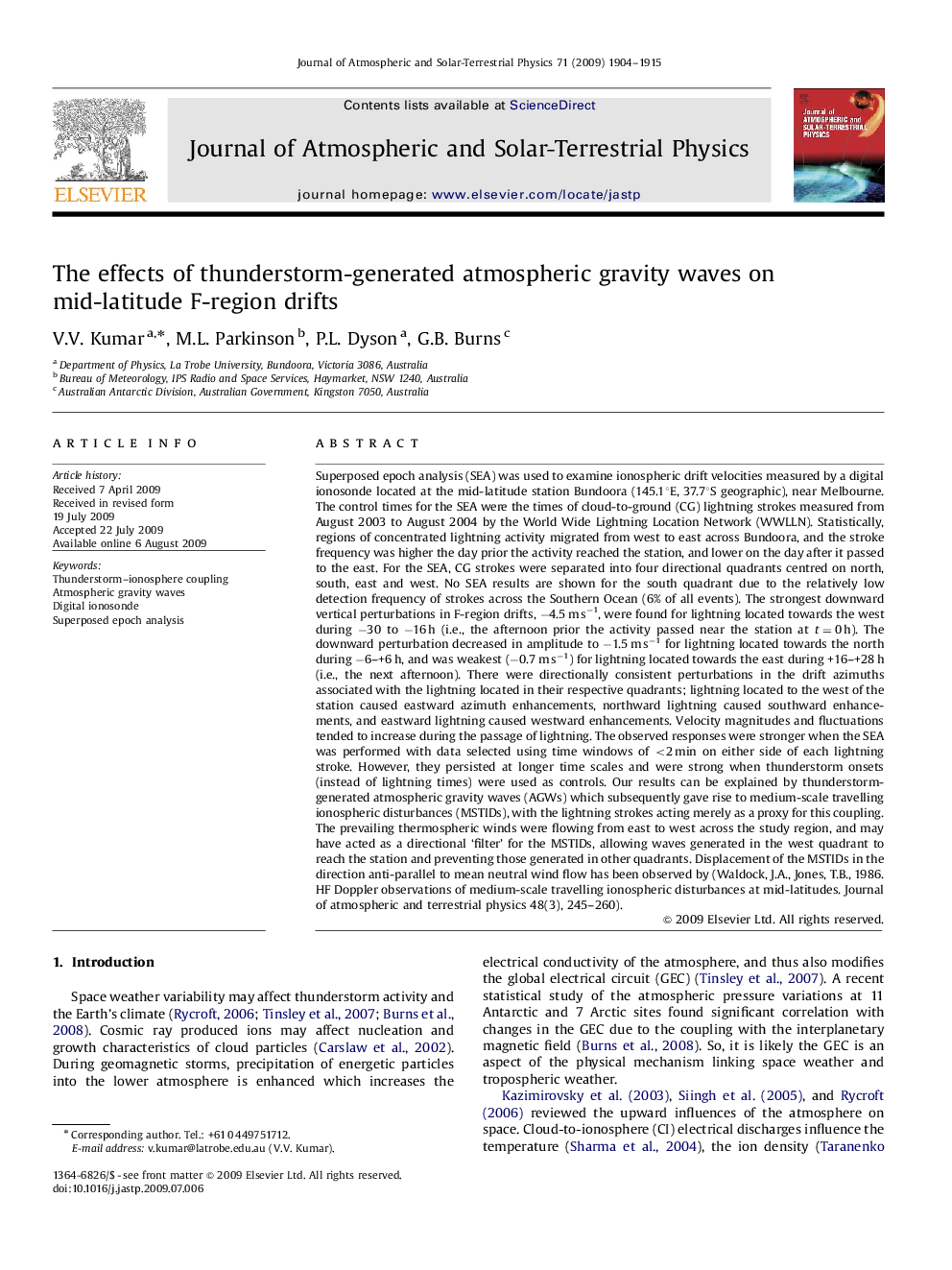| کد مقاله | کد نشریه | سال انتشار | مقاله انگلیسی | نسخه تمام متن |
|---|---|---|---|---|
| 1777671 | 1523668 | 2009 | 12 صفحه PDF | دانلود رایگان |
عنوان انگلیسی مقاله ISI
The effects of thunderstorm-generated atmospheric gravity waves on mid-latitude F-region drifts
دانلود مقاله + سفارش ترجمه
دانلود مقاله ISI انگلیسی
رایگان برای ایرانیان
کلمات کلیدی
موضوعات مرتبط
مهندسی و علوم پایه
علوم زمین و سیارات
فیزیک زمین (ژئو فیزیک)
پیش نمایش صفحه اول مقاله

چکیده انگلیسی
Superposed epoch analysis (SEA) was used to examine ionospheric drift velocities measured by a digital ionosonde located at the mid-latitude station Bundoora (145.1°E, 37.7°S geographic), near Melbourne. The control times for the SEA were the times of cloud-to-ground (CG) lightning strokes measured from August 2003 to August 2004 by the World Wide Lightning Location Network (WWLLN). Statistically, regions of concentrated lightning activity migrated from west to east across Bundoora, and the stroke frequency was higher the day prior the activity reached the station, and lower on the day after it passed to the east. For the SEA, CG strokes were separated into four directional quadrants centred on north, south, east and west. No SEA results are shown for the south quadrant due to the relatively low detection frequency of strokes across the Southern Ocean (6% of all events). The strongest downward vertical perturbations in F-region drifts, â4.5 m sâ1, were found for lightning located towards the west during â30 to â16 h (i.e., the afternoon prior the activity passed near the station at t=0 h). The downward perturbation decreased in amplitude to â1.5 m sâ1 for lightning located towards the north during â6-+6 h, and was weakest (â0.7 m sâ1) for lightning located towards the east during +16-+28 h (i.e., the next afternoon). There were directionally consistent perturbations in the drift azimuths associated with the lightning located in their respective quadrants; lightning located to the west of the station caused eastward azimuth enhancements, northward lightning caused southward enhancements, and eastward lightning caused westward enhancements. Velocity magnitudes and fluctuations tended to increase during the passage of lightning. The observed responses were stronger when the SEA was performed with data selected using time windows of <2 min on either side of each lightning stroke. However, they persisted at longer time scales and were strong when thunderstorm onsets (instead of lightning times) were used as controls. Our results can be explained by thunderstorm-generated atmospheric gravity waves (AGWs) which subsequently gave rise to medium-scale travelling ionospheric disturbances (MSTIDs), with the lightning strokes acting merely as a proxy for this coupling. The prevailing thermospheric winds were flowing from east to west across the study region, and may have acted as a directional 'filter' for the MSTIDs, allowing waves generated in the west quadrant to reach the station and preventing those generated in other quadrants. Displacement of the MSTIDs in the direction anti-parallel to mean neutral wind flow has been observed by (Waldock, J.A., Jones, T.B., 1986. HF Doppler observations of medium-scale travelling ionospheric disturbances at mid-latitudes. Journal of atmospheric and terrestrial physics 48(3), 245-260).
ناشر
Database: Elsevier - ScienceDirect (ساینس دایرکت)
Journal: Journal of Atmospheric and Solar-Terrestrial Physics - Volume 71, Issues 17â18, December 2009, Pages 1904-1915
Journal: Journal of Atmospheric and Solar-Terrestrial Physics - Volume 71, Issues 17â18, December 2009, Pages 1904-1915
نویسندگان
V.V. Kumar, M.L. Parkinson, P.L. Dyson, G.B. Burns,